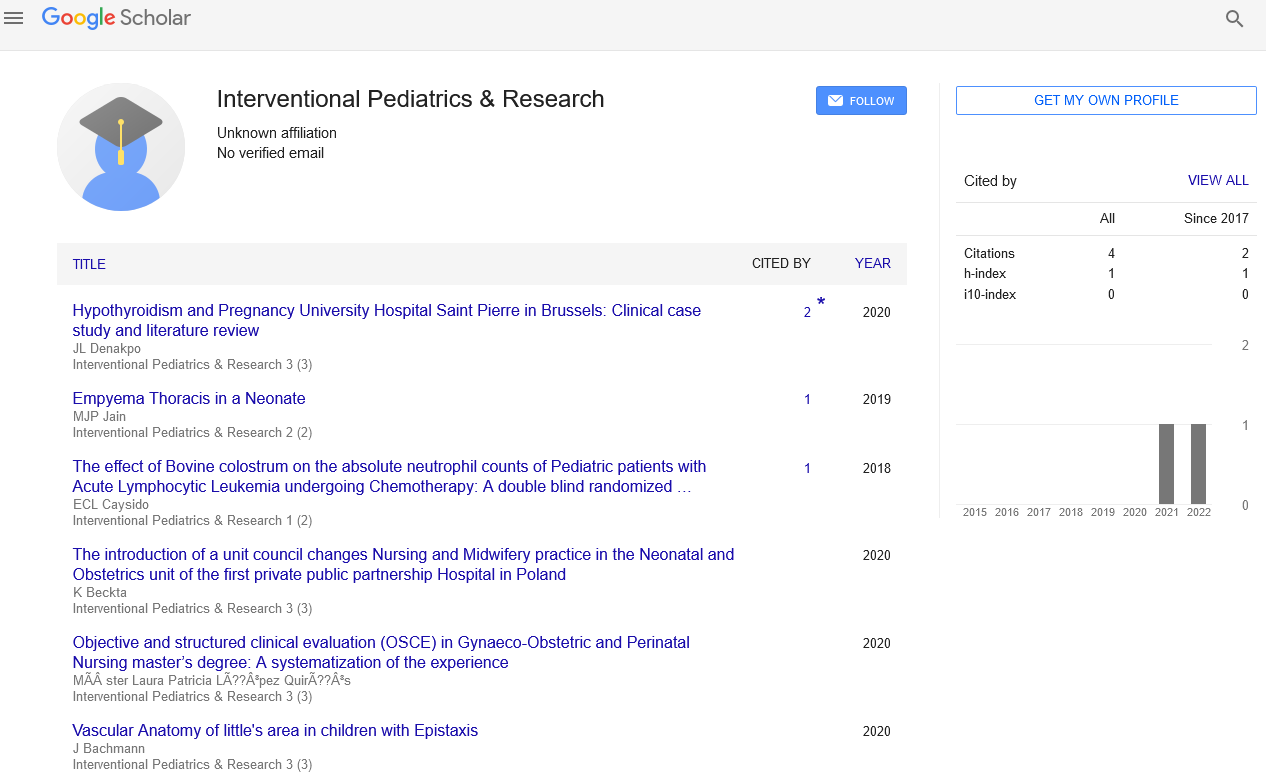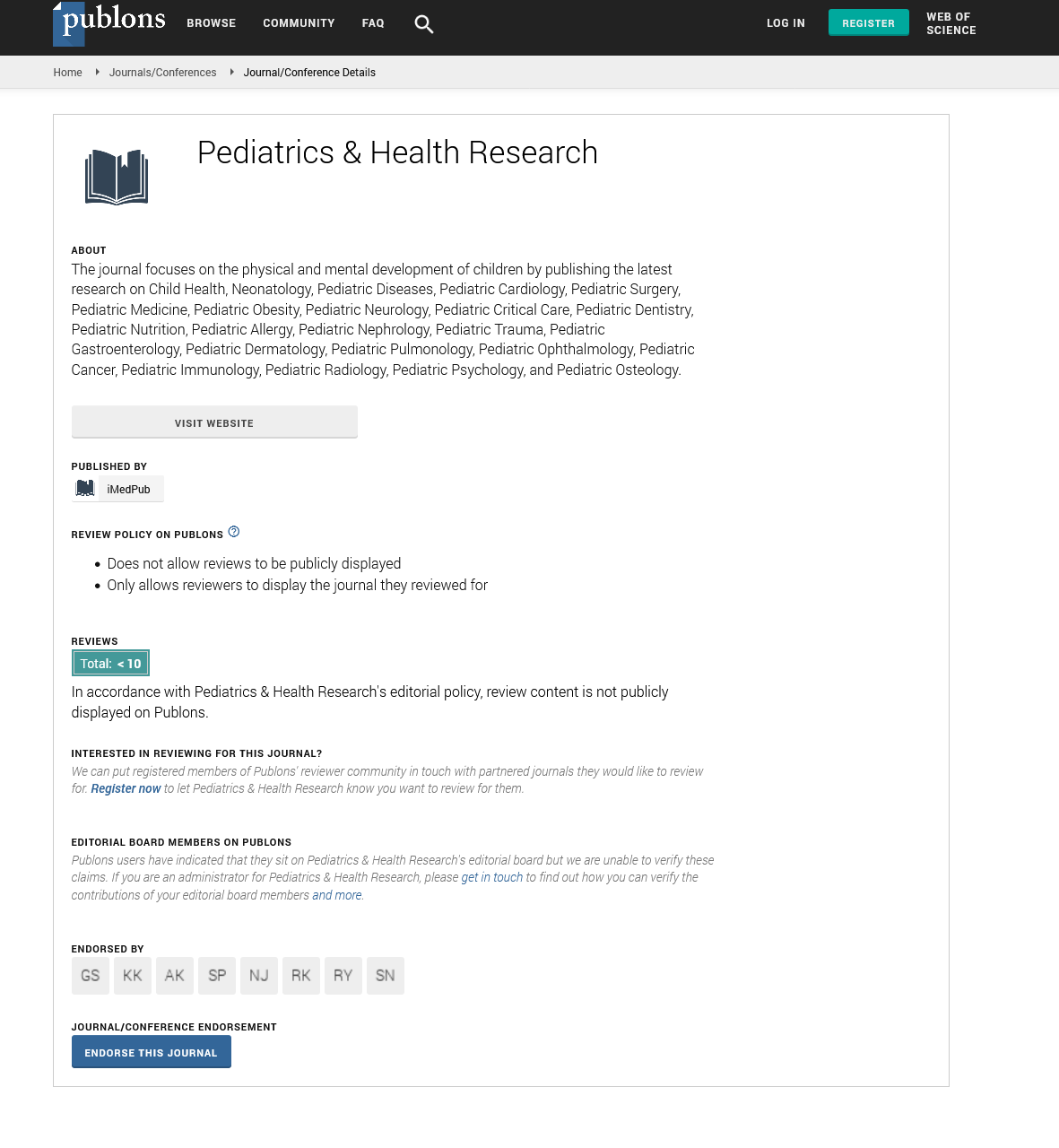Editorial - Interventional Pediatrics & Research (2023) Volume 6, Issue 3
In a context with limited resources, a congenital foetal neck abnormality presents diagnostic and treatment challenges
Lalit Behej*
Department of Medicine, University of Illinois–Chicago, Chicago
- *Corresponding Author:
- Lalit Behej
Department of Medicine, University of Illinois–Chicago, Chicago
E-mail: Lalit23@gmail.com
Abstract
Congenital fetal neck abnormalities pose significant diagnostic and treatment challenges, particularly in contexts with limited resources. This abstract highlights the complexities and hurdles faced by healthcare providers when managing such cases under resourceconstrained conditions.Limited resources, including inadequate healthcare infrastructure, a scarcity of specialized medical personnel, and financial constraints, hinder the comprehensive evaluation and management of congenital fetal neck abnormalities. These abnormalities encompass a wide spectrum of conditions, such as cervical masses, cystic hygromas, bronchial cleft anomalies, and neck teratomas, each requiring individualized diagnostic approaches and treatment strategies. In settings with limited resources, the diagnostic process for fetal neck abnormalities is often compromised due to the unavailability of advanced imaging techniques and specialized prenatal screening programs. This can result in delayed or inaccurate diagnosis, hindering timely intervention and appropriate management planning. The treatment challenges are further exacerbated by limited access to surgical facilities, paediatric specialists, and neonatal intensive care units. Surgical interventions for congenital neck abnormalities necessitate skilled surgeons, anaesthesia support, and post-operative care, which may be insufficient or unavailable in resource-constrained environments. Consequently, the availability and affordability of treatment options may be severely restricted, impacting the overall outcomes and long-term prognosis for affected infants. The psychological impact on parents and families of affected infants should not be underestimated, as they may face emotional distress and lack of adequate support networks in resource-limited settings. The dearth of counselling services and educational resources compounds the difficulties faced by parents in understanding the condition and making informed decisions regarding their child’s care. Addressing these diagnostic and treatment challenges in a context with limited resources requires a multi-faceted approach. Enhancing healthcare infrastructure, investing in training and education of healthcare professionals, and expanding access to affordable prenatal screening and diagnostic tools are critical steps. Collaborative efforts between local healthcare providers, international organizations, and public health initiatives can help bridge the gap and improve outcomes for infants with congenital fetal neck abnormalities. The diagnostic and treatment challenges associated with congenital fetal neck abnormalities are particularly pronounced in contexts with limited resources. Addressing these challenges necessitates a comprehensive approach that encompasses improvements in healthcare infrastructure, increased accessibility to diagnostic tools and specialists, and enhanced support for affected families. By doing so, we can strive to provide better care and outcomes for infants with these complex conditions, even in resource-constrained settings.
Keywords
Fetal neck abnormalities • Cystic hygromas • Neck teratomas • Surgical
Introduction
Congenital fetal neck abnormalities pose significant diagnostic and treatment challenges, particularly in contexts with limited resources. These abnormalities encompass a range of conditions affecting the development and structure of the neck in the developing foetus. In resourceconstrained settings, healthcare providers face unique obstacles in accurately diagnosing these conditions and providing effective treatment options. This article aims to explore the complexities and challenges encountered in the diagnosis and treatment of congenital fetal neck abnormalities within limited resource settings [1,2].
Limited access to advanced imaging
One of the primary challenges in diagnosing fetal neck abnormalities in resource-limited settings is the limited access to advanced imaging techniques. Diagnostic tools such as fetal ultrasound, magnetic resonance imaging (MRI), and three-dimensional (3D) ultrasound are essential for accurate assessment. However, these modalities may be scarce or unavailable in under-resourced areas, making it difficult to obtain precise anatomical details required for proper diagnosis [3].
Expertise and training
Another significant challenge is the scarcity of specialized healthcare providers with expertise in diagnosing and treating congenital fetal neck abnormalities [4]. These conditions often require a multidisciplinary approach involving obstetricians, primatologists, neonatologists, and paediatric surgeons. In settings where medical professionals lack comprehensive training in managing these complex cases, the accurate diagnosis and appropriate management of these conditions become arduous tasks [5].
Financial constraints
Limited financial resources can severely impact the diagnostic and treatment options available for congenital fetal neck abnormalities. Advanced imaging techniques, surgical interventions, and postnatal care can be costly, and in settings with constrained budgets, these expenses may not be feasible. The lack of financial support may result in delayed or suboptimal diagnostic evaluations, inadequate prenatal counselling, and limited treatment options for affected infants [6].
Limited access to prenatal care
In resource-limited settings, access to prenatal care may be limited or inconsistent. Prenatal screenings and routine ultrasound examinations play a crucial role in detecting fetal abnormalities, including those affecting the neck. However, the lack of regular prenatal care can delay the identification of congenital neck abnormalities until later stages of pregnancy or even postnatal, reducing the opportunity for early intervention [7].
Infrastructure and surgical facilities
The absence of well-equipped surgical facilities and neonatal intensive care units (NICUs) can further exacerbate the challenges associated with treating congenital fetal neck abnormalities [8]. Surgical interventions, such as tracheostomy or corrective surgeries, may be unavailable or limited, compromising the options for effective management. Inadequate infrastructure also hinders postnatal care, rehabilitation, and longterm monitoring required for these complex conditions [9,10].
Conclusion
Congenital fetal neck abnormalities present significant diagnostic and treatment challenges, particularly in resource-limited settings. The limited availability of advanced imaging, expertise, financial constraints, limited access to prenatal care, and inadequate infrastructure all contribute to the complexity of managing these conditions. Addressing these challenges requires a comprehensive approach involving increased access to diagnostic tools, specialized training for healthcare providers, financial support for families, improved prenatal care, and enhanced surgical facilities. By addressing these issues, healthcare systems can strive to provide better outcomes for infants affected by congenital fetal neck abnormalities, even in resource-constrained environments.
References
- Howard L, Mancuso AC, Ryan GL. Müllerian aplasia with severe hematometra: A case report of diagnosis and management in a low resource setting.J Podiatry Adolesc Gyneco. l32, 189-192(2019).
- Persani L. Central hypothyroidism: pathogenic, diagnostic, and therapeutic challenges. J Clin Endocr. 97, 3068-3078(2012).
- Jomaa M. A challenging diagnosis and management of Herlyn-Werner-Wunderlich syndrome in low-resource settings: a case report complicated with hydronephrosis. Ann Med Surg. 70,102-843(2021).
- Dimopoulos G. Cardiovascular complications of down syndrome: scoping review and expert consensus. Circulation. 147, 425-441(2023).
- Ballantyne A, Newson A, Luna F et al. Prenatal diagnosis and abortion for congenital abnormalities: is it ethical to provide one without the other?. AJOB.9, 48-56 (2009).
- Timothy E Obstetric ultrasound use in low and middle income countries: a narrative review. Reprod health .15, 1-26(2018).
- Melamed N. FIGO (international Federation of Gynecology and obstetrics) initiative on fetal growth: best pracice advice for screening, diagnosis, and management of fetal growth restriction. Int J Gynaecol Obstet. 1,152 -352(2021).
- Mbonda A. Diagnosis of Fraser syndrome missed out until the age of six months old in a low-resource setting: a case report. BMC paediatrics. 19, (2019).
- Dolk H, Leke A Z, Whitfield P et al. Global birth defects app: An innovative tool for describing and coding congenital anomalies at birth in low resource settings. Birth Defects Res. 113, 1057-1073(2021).
- Bello AL, Acquah A, Quartey JN et al. Knowledge of pregnant women about birth defects. BMC Pregnancy and Childbirth 13, 1471-2393(2013).
Indexed at, Google Scholar, Crossref
Indexed at, Google Scholar, Crossref
Indexed at, Google Scholar, Crossref
Indexed at, Google Scholar, Crossref
Indexed at, Google Scholar, Crossref
Indexed at, Google Scholar, Crossref
Indexed at, Google Scholar, Crossref
Indexed at, Google Scholar, Crossref
Indexed at, Google Scholar, Crossref


